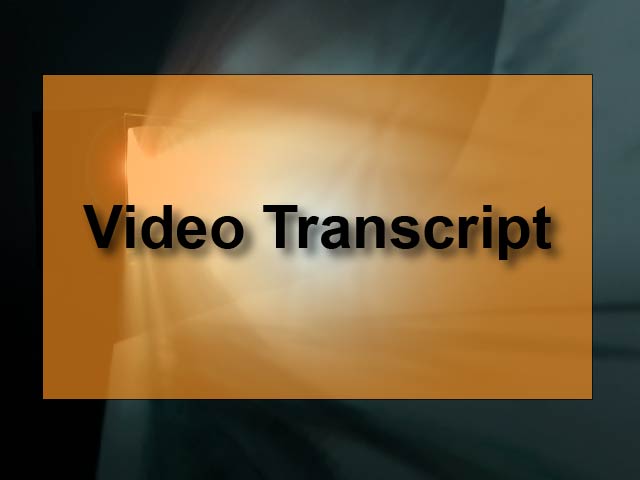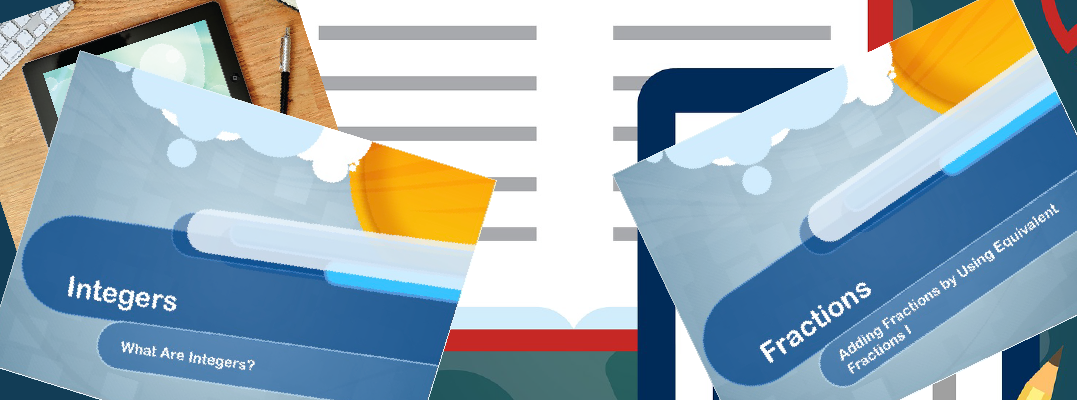Content Showcase: Video Transcripts
Media4Math has video transcripts for many of our videos. When you subscribe to Media4Math, you can download these transcripts.
This is a growing collection of resources, so keep coming back!
(Want to learn more about our subscription packages? Click here.)
| Title | Description | Thumbnail Image | Curriculum Topics |
|---|---|---|---|
Video Transcript: Geometry Applications: 3D Geometry, Segment 2: Pyramids |
Video Transcript: Geometry Applications: 3D Geometry, Segment 2: PyramidsThis is the transcript for the video of same title. Video contents: Rectangular Prisms. Mayan pyramids are essentially stacks of rectangular prisms. The volume of each successive level is a percentage decrease of its lower neighbor. This introduces the notion of a geometric sequence and series, including an infinite series. |

|
3-Dimensional Figures and Applications of 3D Geometry |
Video Transcript: Geometry Applications: 3D Geometry, Segment 3: Cylinders |
Video Transcript: Geometry Applications: 3D Geometry, Segment 3: CylindersThis is the transcript for the video of same title. Video contents: The Shanghai Tower in China is a stack of cylindrical shapes, where each successive layer is a percentage decrease of its lower neighbor. As with the previous section, this introduces the notion of a geometric sequence and series. |

|
3-Dimensional Figures and Applications of 3D Geometry |
Video Transcript: Geometry Applications: Angles and Planes |
Video Transcript: Geometry Applications: Angles and PlanesThis is the transcript for the video of same title. Video contents: In this program we explore the properties of angles and planes. We do this in the context of two real-world applications. In the first, we explore Japan's Himeji Castle and in the process learn about different types of angles and how they're used in a defensive fortification. In the second applicaiton we explore sedimentary rock layers as examples of parallel planes. We explore the Burgess Shale fossils. |

|
Definition of an Angle and Applications of Angles and Planes |
Video Transcript: Geometry Applications: Angles and Planes, Segment 1: Introduction |
Video Transcript: Geometry Applications: Angles and Planes, Segment 1: IntroductionThis is the transcript for the video of same title. Video contents: The observatory in Arecibo, Puerto Rico provides astronomers insights into the structure of our solar system. Geometrically, the solar system relies on the plane known as the ecliptic. In studying the Earth's orbit it is important to know that the Earth's axis of rotation is at an angle relative to the ecliptic. This segment introduces the key themes of the program. |

|
Applications of Points and Lines |
Video Transcript: Geometry Applications: Angles and Planes, Segment 2: Angles |
Video Transcript: Geometry Applications: Angles and Planes, Segment 2: AnglesThis is the transcript for the video of same title. Video contents: Himeji castle in Japan is a marvel of architecture and a startling example of geometry and military science. The castle was used to protect samurai armies from invading forces, and the use of acute, obtuse, and right angles as part of the defense structure provide many opportunities for exploring the nature of geometric angles. |

|
Applications of Points and Lines |
Video Transcript: Geometry Applications: Angles and Planes, Segment 3: Planes |
Video Transcript: Geometry Applications: Angles and Planes, Segment 3: PlanesThis is the transcript for the video of same title. Video contents: In the Canadian Rockies, the Burgess Shale fossils provide a window to prehistoric Earth. Fossil layers are folded into sedimentary rocks. And sedimentary rocks are examples of parallel planes. This segment uses the properties of planes to analyze fossils. |

|
Applications of Points and Lines |
Video Transcript: Geometry Applications: Area and Volume |
Video Transcript: Geometry Applications: Area and VolumeThis is the transcript for the video of same title. Video contents: In this program we look at applications of area and volume. We do this in the context of three real-world applications. In the first, we look at the sinking of the Titanic in the context of volume and density. In the second application we look at the glass pyramid at the Louvre Museum and calculate its surface area. |

|
Applications of Surface Area and Volume |
Video Transcript: Geometry Applications: Area and Volume, Segment 1: Volume and Density. |
Video Transcript: Geometry Applications: Area and Volume, Segment 1: Volume and Density.This is the transcript for the video of same title. Video contents: The sinking of the Titanic provides an opportunity to explore volume, density, and buoyancy. Students construct a mathematical model of the Titanic to determine why it sank and what could have been done to prevent it from sinking. |

|
Applications of Surface Area and Volume |
Video Transcript: Geometry Applications: Area and Volume, Segment 2: Surface Area. |
Video Transcript: Geometry Applications: Area and Volume, Segment 2: Surface Area.This is the transcript for the video of same title. Video contents: The glass-paneled pyramid at the Louvre Museum in Paris is a tessellation of rhombus-shaped glass panels. Students create a model of the pyramid to calculate the number of panels used to cover the surface area of the pyramid. |

|
Applications of Surface Area and Volume |
Video Transcript: Geometry Applications: 3D Geometry |
Video Transcript: Geometry Applications: 3D GeometryThis is the transcript for the video of same title. Video contents: In this program we explore the properties of three-dimensional figures. We do this in the context of two real-world applications. In the first, we look at the three-dimensional structure of Mayan pyramids. These stair-step structures provide a unique opportunity to also explore sequences and series. In the second application we look at the Shanghai Tower as an example of cylindrically shaped structures. |

|
3-Dimensional Figures and Applications of 3D Geometry |
Video Transcript: Geometry Applications: Circles |
Video Transcript: Geometry Applications: CirclesThis is the transcript for the video of same title. Video contents: In this program we explore the properties of circles. We do this in the context of two real-world applications. In the first, we look at the design of the Roman Coliseum and explore how circular shapes could have been used to design this elliptical structure. In the second application we look at the Roman Pantheon, specifically its spherical dome, to see how the properties of chords and secants help clarify its unique design. |

|
Applications of Circles |
Video Transcript: Geometry Applications: Circles, Segment 1: The Basics of Circles |
Video Transcript: Geometry Applications: Circles, Segment 1: The Basics of CirclesThis is the transcript for the video of same title. Video contents: We visit Chaco Canyon in New Mexico to explore the circular kivas and in the process discover how circular buildings have been used to study the heavens. |

|
Applications of Circles |
Video Transcript: Geometry Applications: Circles, Segment 2: Circles and Arcs |
Video Transcript: Geometry Applications: Circles, Segment 2: Circles and ArcsThis is the transcript for the video of same title. Video contents: The Roman Coliseum is a large elliptical structure. Yet, the Romans likely used circular arcs to build it. This segment explores the properties of circles and shows how arcs can be used to create elliptical shapes. |

|
Applications of Circles |
Video Transcript: Geometry Applications: Circles, Segment 3: Chords and Inscribed Angles |
Video Transcript: Geometry Applications: Circles, Segment 3: Chords and Inscribed AnglesThis is the transcript for the video of same title. Video contents: The Roman Pantheon is a domed structure that shows a keen awareness of the position of the sun throughout the year. The source of light from the top of the dome allows for the exploration of chords, inscribed angles, central angles, and intercepted arcs. |

|
Applications of Circles |
Video Transcript: Geometry Applications: Coordinate Geometry |
Video Transcript: Geometry Applications: Coordinate GeometryThis is the transcript for the video of same title. Video contents: In this program we look at applications of coordinate geometry. We do this in the context of three real-world applications. In the first, we look at longitude and latitude as a spherical coordinate system for navigation. In the second application we look at decimal values for longitude and latitude in a two-dimensional system for locating buried treasure at sea. |

|
Applications of Coordinate Geometry |
Video Transcript: Geometry Applications: Coordinate Geometry, Segment 1: Longitude and Latitude |
Video Transcript: Geometry Applications: Coordinate Geometry, Segment 1: Longitude and LatitudeThis is the transcript for the video of same title. Video contents: Greenwich, England, is the location of the Prime Meridian and offers a point of departure for a discussion of the longitude and latitude coordinate system. |

|
Applications of Coordinate Geometry |
Video Transcript: Geometry Applications: Coordinate Geometry, Segment 2: Rectangular Coordinates |
Video Transcript: Geometry Applications: Coordinate Geometry, Segment 2: Rectangular CoordinatesThis is the transcript for the video of same title. Video contents: Centuries ago a Spanish galleon, The Atocha, sank off the coast of Florida, taking its gold treasure down with it. Aside from the technology used to recover the treasure, it was a rectangular coordinate system that made such an endeavor possible. |

|
Applications of Coordinate Geometry |
Video Transcript: Geometry Applications: Coordinate Geometry, Segment 3: Polar Coordinates. |
Video Transcript: Geometry Applications: Coordinate Geometry, Segment 3: Polar Coordinates.This is the transcript for the video of same title. Video contents: The Guggenheim Museum in New York City has a spiral shape that is an example of a polar coordinate graph. This shape, found often in nature, is a way to understand the Fibonacci Sequence. |

|
Applications of Coordinate Geometry |
Video Transcript: Geometry Applications: Points and Lines |
Video Transcript: Geometry Applications: Points and LinesThis is the transcript for the video of same title. Video contents: In this program we explore the properties of points and lines. We do this in the context of two real-world applications. In the first, we go to CERN and learn about the Large Hadron Collidor. We look at how points can represent particle positions in space and look at properties of points and lines. In the second application we investigate the properties of lines in the context of city grids. |

|
Applications of Points and Lines |
Video Transcript: Geometry Applications: Points and Lines, Segment 1: Introduction |
Video Transcript: Geometry Applications: Points and Lines, Segment 1: IntroductionThis is the transcript for the video of same title. Video contents: Our understanding of geometry owes much to the ancient Greeks. We visit the ancient Acropolis and explore some of its geometric secrets. |

|
Applications of Points and Lines |
